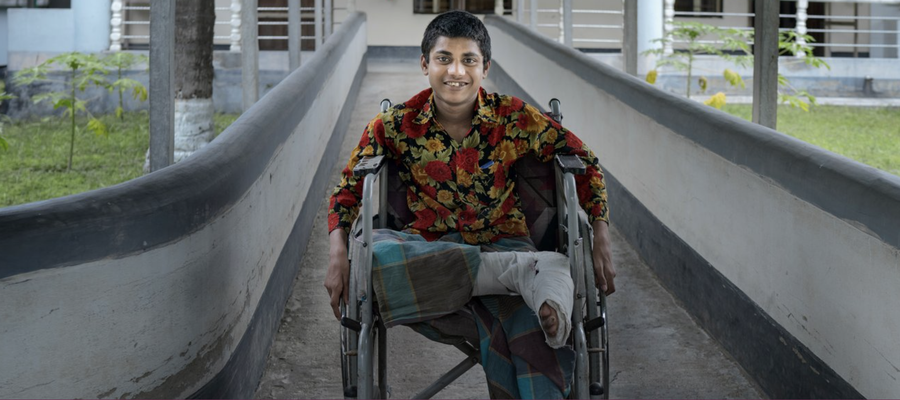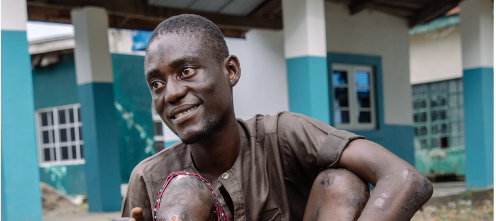Is it possible to restore feeling to hands and feet that have been damaged by leprosy?

Ulcers are one of leprosy’s most frustrating challenges. They affect around 30 percent of patients and are a chronic problem that can lead to repeated hospitalisations and a lifetime of watchfulness for patients.
All ulcers in leprosy are caused by a loss of sensation. The leprosy bacteria damages nerves and those nerves stop functioning. The consequence is that patients do not feel when their skin is being damaged; you could walk for miles with a sharp stone in your shoe or pick up a hot pan without realising the damage you are doing. Although there is no pain, the ulcers that occur are still very dangerous. In worst-case scenarios, ulcers can lead to sepsis and amputation.
All ulcers in leprosy are caused by a loss of sensation. The leprosy bacteria damages nerves and those nerves stop functioning. The consequence is that patients do not feel when their skin is being damaged; you could walk for miles with a sharp stone in your shoe or pick up a hot pan without realising the damage you are doing. Although there is no pain, the ulcers that occur are still very dangerous. In worst-case scenarios, ulcers can lead to sepsis and amputation.
For millennia, it has been an immutable truth that leprosy causes a loss of sensation for patients. It is a haunting hallmark of the disease, one that many patients must learn to live with. But what if we could restore feeling to skin that had lost sensation? Until now that has been unimaginable, but scientists are now working on making it a reality.
30% of all leprosy patients will be affected by Ulcers.
How can we restore sensation when there is none?
A researcher in India, Professor Pawan Agarwal, had been looking closely at ulcers caused by diabetes. These ulcers are very similar in character to leprosy ulcers and this researcher saw that perhaps sensation could be restored through surgery.
Dr Indra Napit, Head of Research at The Leprosy Mission Nepal, was asked to peer review this study and was instantly fascinated.
“As soon as I read the paper, I knew I had to reach out to this professor and learn more. His discovery was fascinating. Leprosy patients lose sensation in their feet because the leprosy bacteria causes damage to the Tibialis Posterior nerve; this is the nerve that provides sensation to the plantar of the foot. This researcher had discovered that it would be possible to restore that nerve by attaching it to another nerve in the leg, the Saphenous nerve. If sensation is restored to a patients’ feet, then we no longer have the risk of ulcers; it would be revolutionary.”
“As soon as I read the paper, I knew I had to reach out to this professor and learn more. His discovery was fascinating. Leprosy patients lose sensation in their feet because the leprosy bacteria causes damage to the Tibialis Posterior nerve; this is the nerve that provides sensation to the plantar of the foot. This researcher had discovered that it would be possible to restore that nerve by attaching it to another nerve in the leg, the Saphenous nerve. If sensation is restored to a patients’ feet, then we no longer have the risk of ulcers; it would be revolutionary.”
After surgery to attach the Saphenous nerve to the Tibialis Posterior nerve, patients require three weeks in a plaster cast to protect the nerves so that the leg will heal well. After these three weeks, the cast is removed and the patient can be discharged from hospital. It takes between six months and a year for the feeling to be restored, but the initial study in India shows that around 80 percent of patients have excellent results.
After surgery to attach the Saphenous nerve to the Tibialis Posterior nerve, patients require three weeks in a plaster cast to protect the nerves so that the leg will heal well. After these three weeks, the cast is removed and the patient can be discharged from hospital. It takes between six months and a year for the feeling to be restored, but the initial study in India shows that around 80 percent of patients have excellent results.
If sensation is restored to a patients’ feet, then we no longer have the risk of ulcers; it would be revolutionary.
Dr Indra Napit

The Leprosy Mission Nepal are moving forward with a leprosy-specific trial
Dr Indra has started work on trialling this procedure in leprosy patients. His team have begun enrolment for the trial and are hoping to conduct the surgeries in January and February 2025.
“We have to do the enrolment carefully. The outcome of the surgery depends on whether the Saphenous nerve has been damaged and for how long the Tibalialis Posterior nerve has been causing a loss of sensation. We are aiming to enrol 15 patients who can give us an indication of how successful this procedure can be in leprosy.
“After we conduct the surgeries at the start of 2025, we will have a six-month and twelve-month follow up with the patients. We will write a paper on our outcomes and hope to have it published by the end of the year. We are also going to explore the possibility that this procedure could work on the hands as well as the feet.”
This innovation could bring results for patients very soon
If Dr Indra and his team can prove the efficacy of this procedure for patients, they could begin training teams across the world by the end of 2025. We could begin to see feeling restored in patients across the world very soon.
“If you think that around 30 percent of leprosy patients experience ulcers and then you consider the time it takes for them to be healed, the time they invest in their own self-care, the cost of extended hospital stays for both patients and hospitals. Then consider the possibility that we could eliminate so much of that with this new procedure. The results for patients would be extraordinary and for hospital teams it would totally change the landscape of leprosy care.
“If you think that around 30 percent of leprosy patients experience ulcers and then you consider the time it takes for them to be healed, the time they invest in their own self-care, the cost of extended hospital stays for both patients and hospitals. Then consider the possibility that we could eliminate so much of that with this new procedure. The results for patients would be extraordinary and for hospital teams it would totally change the landscape of leprosy care.
“With restoration of sensation in feet, patients will be aware of any pressure or cracks in the feet. This should minimise the ulceration and recurrence of ulcers at the planter of feet. We still recommend patients to continue self-care of their feet to keep their feet in good condition, but we hope the need of self-care will be less than before the nerve transfer.”
Takeaways
- For the first time, we have a chance to restore sensation in the hands and feet of people who have lost sensation because of leprosy.
- A study is underway and preliminary results could be ready before the end of the year
- This new surgical technique could be rolled out globally as early as 2026